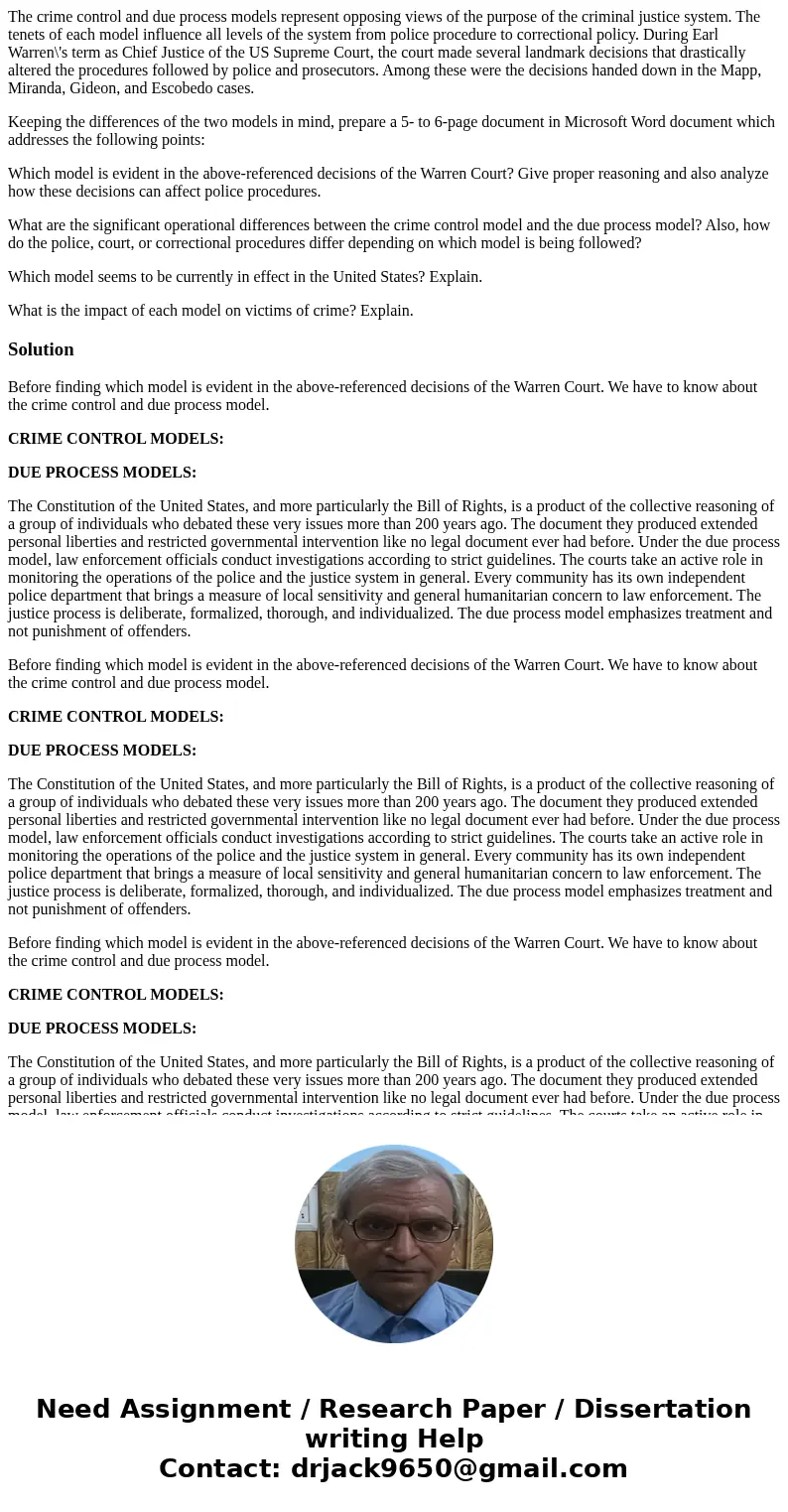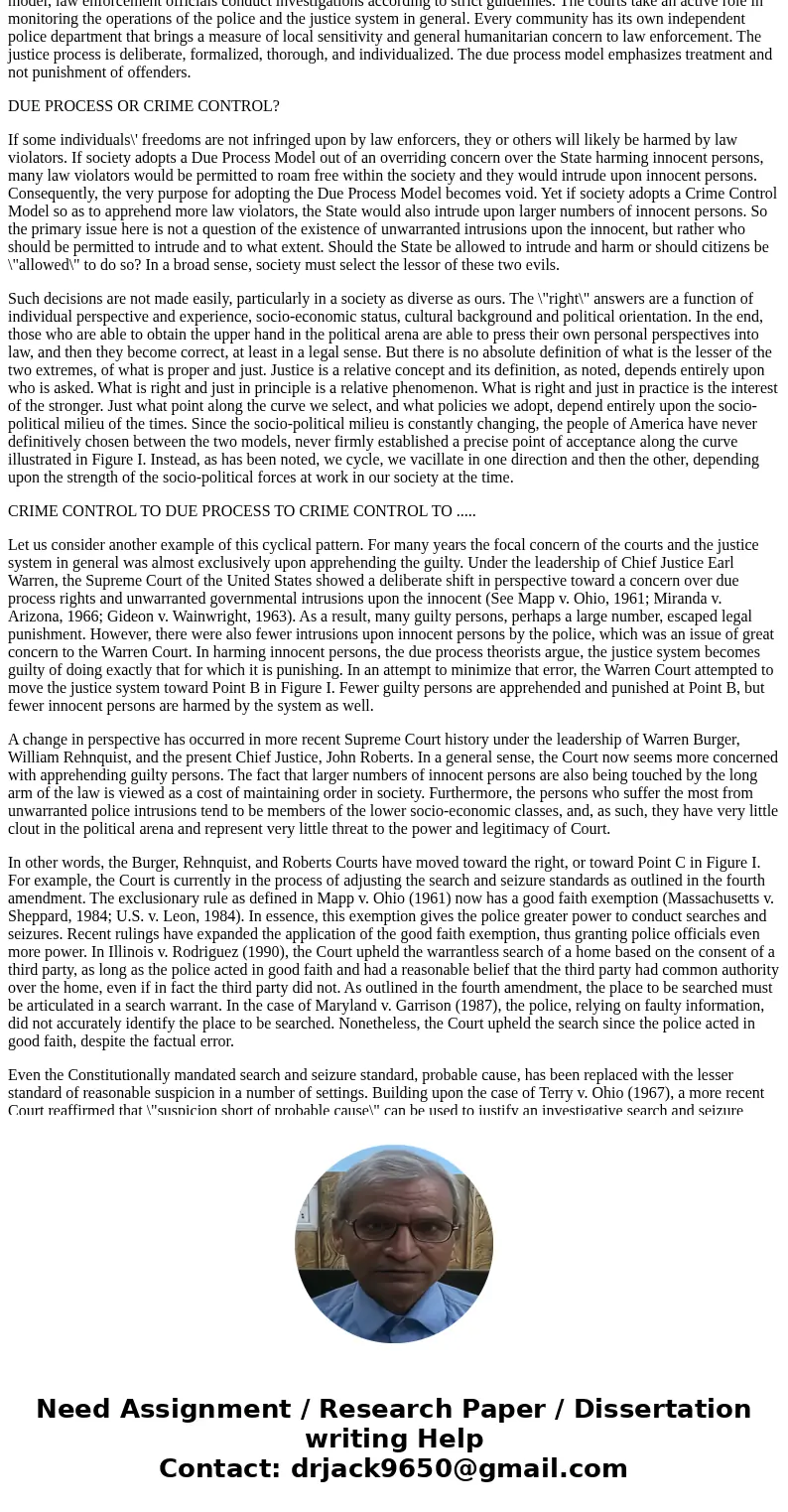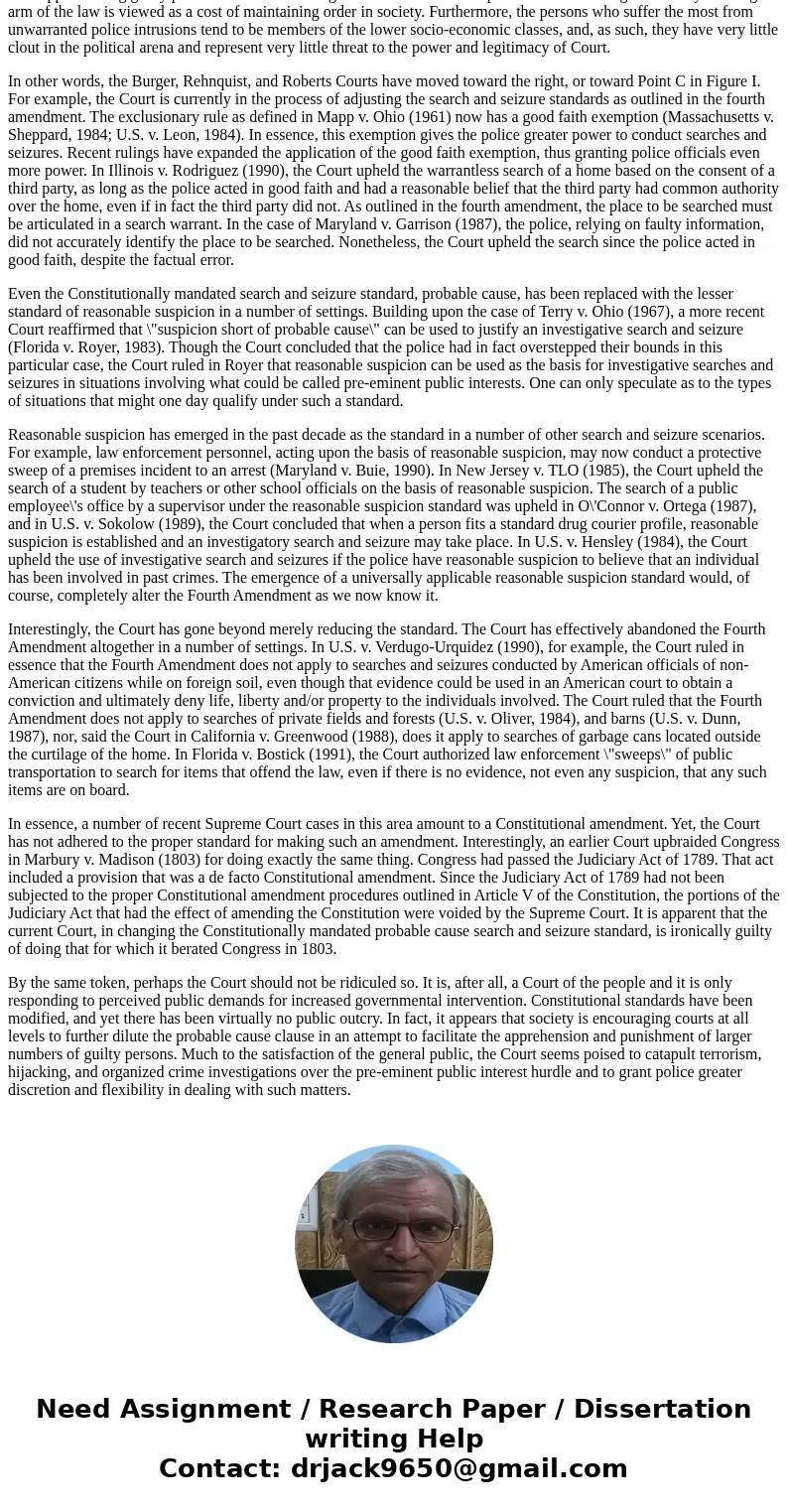The crime control and due process models represent opposing
The crime control and due process models represent opposing views of the purpose of the criminal justice system. The tenets of each model influence all levels of the system from police procedure to correctional policy. During Earl Warren\'s term as Chief Justice of the US Supreme Court, the court made several landmark decisions that drastically altered the procedures followed by police and prosecutors. Among these were the decisions handed down in the Mapp, Miranda, Gideon, and Escobedo cases.
Keeping the differences of the two models in mind, prepare a 5- to 6-page document in Microsoft Word document which addresses the following points:
Which model is evident in the above-referenced decisions of the Warren Court? Give proper reasoning and also analyze how these decisions can affect police procedures.
What are the significant operational differences between the crime control model and the due process model? Also, how do the police, court, or correctional procedures differ depending on which model is being followed?
Which model seems to be currently in effect in the United States? Explain.
What is the impact of each model on victims of crime? Explain.
Solution
Before finding which model is evident in the above-referenced decisions of the Warren Court. We have to know about the crime control and due process model.
CRIME CONTROL MODELS:
DUE PROCESS MODELS:
The Constitution of the United States, and more particularly the Bill of Rights, is a product of the collective reasoning of a group of individuals who debated these very issues more than 200 years ago. The document they produced extended personal liberties and restricted governmental intervention like no legal document ever had before. Under the due process model, law enforcement officials conduct investigations according to strict guidelines. The courts take an active role in monitoring the operations of the police and the justice system in general. Every community has its own independent police department that brings a measure of local sensitivity and general humanitarian concern to law enforcement. The justice process is deliberate, formalized, thorough, and individualized. The due process model emphasizes treatment and not punishment of offenders.
Before finding which model is evident in the above-referenced decisions of the Warren Court. We have to know about the crime control and due process model.
CRIME CONTROL MODELS:
DUE PROCESS MODELS:
The Constitution of the United States, and more particularly the Bill of Rights, is a product of the collective reasoning of a group of individuals who debated these very issues more than 200 years ago. The document they produced extended personal liberties and restricted governmental intervention like no legal document ever had before. Under the due process model, law enforcement officials conduct investigations according to strict guidelines. The courts take an active role in monitoring the operations of the police and the justice system in general. Every community has its own independent police department that brings a measure of local sensitivity and general humanitarian concern to law enforcement. The justice process is deliberate, formalized, thorough, and individualized. The due process model emphasizes treatment and not punishment of offenders.
Before finding which model is evident in the above-referenced decisions of the Warren Court. We have to know about the crime control and due process model.
CRIME CONTROL MODELS:
DUE PROCESS MODELS:
The Constitution of the United States, and more particularly the Bill of Rights, is a product of the collective reasoning of a group of individuals who debated these very issues more than 200 years ago. The document they produced extended personal liberties and restricted governmental intervention like no legal document ever had before. Under the due process model, law enforcement officials conduct investigations according to strict guidelines. The courts take an active role in monitoring the operations of the police and the justice system in general. Every community has its own independent police department that brings a measure of local sensitivity and general humanitarian concern to law enforcement. The justice process is deliberate, formalized, thorough, and individualized. The due process model emphasizes treatment and not punishment of offenders.
DUE PROCESS OR CRIME CONTROL?
If some individuals\' freedoms are not infringed upon by law enforcers, they or others will likely be harmed by law violators. If society adopts a Due Process Model out of an overriding concern over the State harming innocent persons, many law violators would be permitted to roam free within the society and they would intrude upon innocent persons. Consequently, the very purpose for adopting the Due Process Model becomes void. Yet if society adopts a Crime Control Model so as to apprehend more law violators, the State would also intrude upon larger numbers of innocent persons. So the primary issue here is not a question of the existence of unwarranted intrusions upon the innocent, but rather who should be permitted to intrude and to what extent. Should the State be allowed to intrude and harm or should citizens be \"allowed\" to do so? In a broad sense, society must select the lessor of these two evils.
Such decisions are not made easily, particularly in a society as diverse as ours. The \"right\" answers are a function of individual perspective and experience, socio-economic status, cultural background and political orientation. In the end, those who are able to obtain the upper hand in the political arena are able to press their own personal perspectives into law, and then they become correct, at least in a legal sense. But there is no absolute definition of what is the lesser of the two extremes, of what is proper and just. Justice is a relative concept and its definition, as noted, depends entirely upon who is asked. What is right and just in principle is a relative phenomenon. What is right and just in practice is the interest of the stronger. Just what point along the curve we select, and what policies we adopt, depend entirely upon the socio-political milieu of the times. Since the socio-political milieu is constantly changing, the people of America have never definitively chosen between the two models, never firmly established a precise point of acceptance along the curve illustrated in Figure I. Instead, as has been noted, we cycle, we vacillate in one direction and then the other, depending upon the strength of the socio-political forces at work in our society at the time.
CRIME CONTROL TO DUE PROCESS TO CRIME CONTROL TO .....
Let us consider another example of this cyclical pattern. For many years the focal concern of the courts and the justice system in general was almost exclusively upon apprehending the guilty. Under the leadership of Chief Justice Earl Warren, the Supreme Court of the United States showed a deliberate shift in perspective toward a concern over due process rights and unwarranted governmental intrusions upon the innocent (See Mapp v. Ohio, 1961; Miranda v. Arizona, 1966; Gideon v. Wainwright, 1963). As a result, many guilty persons, perhaps a large number, escaped legal punishment. However, there were also fewer intrusions upon innocent persons by the police, which was an issue of great concern to the Warren Court. In harming innocent persons, the due process theorists argue, the justice system becomes guilty of doing exactly that for which it is punishing. In an attempt to minimize that error, the Warren Court attempted to move the justice system toward Point B in Figure I. Fewer guilty persons are apprehended and punished at Point B, but fewer innocent persons are harmed by the system as well.
A change in perspective has occurred in more recent Supreme Court history under the leadership of Warren Burger, William Rehnquist, and the present Chief Justice, John Roberts. In a general sense, the Court now seems more concerned with apprehending guilty persons. The fact that larger numbers of innocent persons are also being touched by the long arm of the law is viewed as a cost of maintaining order in society. Furthermore, the persons who suffer the most from unwarranted police intrusions tend to be members of the lower socio-economic classes, and, as such, they have very little clout in the political arena and represent very little threat to the power and legitimacy of Court.
In other words, the Burger, Rehnquist, and Roberts Courts have moved toward the right, or toward Point C in Figure I. For example, the Court is currently in the process of adjusting the search and seizure standards as outlined in the fourth amendment. The exclusionary rule as defined in Mapp v. Ohio (1961) now has a good faith exemption (Massachusetts v. Sheppard, 1984; U.S. v. Leon, 1984). In essence, this exemption gives the police greater power to conduct searches and seizures. Recent rulings have expanded the application of the good faith exemption, thus granting police officials even more power. In Illinois v. Rodriguez (1990), the Court upheld the warrantless search of a home based on the consent of a third party, as long as the police acted in good faith and had a reasonable belief that the third party had common authority over the home, even if in fact the third party did not. As outlined in the fourth amendment, the place to be searched must be articulated in a search warrant. In the case of Maryland v. Garrison (1987), the police, relying on faulty information, did not accurately identify the place to be searched. Nonetheless, the Court upheld the search since the police acted in good faith, despite the factual error.
Even the Constitutionally mandated search and seizure standard, probable cause, has been replaced with the lesser standard of reasonable suspicion in a number of settings. Building upon the case of Terry v. Ohio (1967), a more recent Court reaffirmed that \"suspicion short of probable cause\" can be used to justify an investigative search and seizure (Florida v. Royer, 1983). Though the Court concluded that the police had in fact overstepped their bounds in this particular case, the Court ruled in Royer that reasonable suspicion can be used as the basis for investigative searches and seizures in situations involving what could be called pre-eminent public interests. One can only speculate as to the types of situations that might one day qualify under such a standard.
Reasonable suspicion has emerged in the past decade as the standard in a number of other search and seizure scenarios. For example, law enforcement personnel, acting upon the basis of reasonable suspicion, may now conduct a protective sweep of a premises incident to an arrest (Maryland v. Buie, 1990). In New Jersey v. TLO (1985), the Court upheld the search of a student by teachers or other school officials on the basis of reasonable suspicion. The search of a public employee\'s office by a supervisor under the reasonable suspicion standard was upheld in O\'Connor v. Ortega (1987), and in U.S. v. Sokolow (1989), the Court concluded that when a person fits a standard drug courier profile, reasonable suspicion is established and an investigatory search and seizure may take place. In U.S. v. Hensley (1984), the Court upheld the use of investigative search and seizures if the police have reasonable suspicion to believe that an individual has been involved in past crimes. The emergence of a universally applicable reasonable suspicion standard would, of course, completely alter the Fourth Amendment as we now know it.
Interestingly, the Court has gone beyond merely reducing the standard. The Court has effectively abandoned the Fourth Amendment altogether in a number of settings. In U.S. v. Verdugo-Urquidez (1990), for example, the Court ruled in essence that the Fourth Amendment does not apply to searches and seizures conducted by American officials of non-American citizens while on foreign soil, even though that evidence could be used in an American court to obtain a conviction and ultimately deny life, liberty and/or property to the individuals involved. The Court ruled that the Fourth Amendment does not apply to searches of private fields and forests (U.S. v. Oliver, 1984), and barns (U.S. v. Dunn, 1987), nor, said the Court in California v. Greenwood (1988), does it apply to searches of garbage cans located outside the curtilage of the home. In Florida v. Bostick (1991), the Court authorized law enforcement \"sweeps\" of public transportation to search for items that offend the law, even if there is no evidence, not even any suspicion, that any such items are on board.
In essence, a number of recent Supreme Court cases in this area amount to a Constitutional amendment. Yet, the Court has not adhered to the proper standard for making such an amendment. Interestingly, an earlier Court upbraided Congress in Marbury v. Madison (1803) for doing exactly the same thing. Congress had passed the Judiciary Act of 1789. That act included a provision that was a de facto Constitutional amendment. Since the Judiciary Act of 1789 had not been subjected to the proper Constitutional amendment procedures outlined in Article V of the Constitution, the portions of the Judiciary Act that had the effect of amending the Constitution were voided by the Supreme Court. It is apparent that the current Court, in changing the Constitutionally mandated probable cause search and seizure standard, is ironically guilty of doing that for which it berated Congress in 1803.
By the same token, perhaps the Court should not be ridiculed so. It is, after all, a Court of the people and it is only responding to perceived public demands for increased governmental intervention. Constitutional standards have been modified, and yet there has been virtually no public outcry. In fact, it appears that society is encouraging courts at all levels to further dilute the probable cause clause in an attempt to facilitate the apprehension and punishment of larger numbers of guilty persons. Much to the satisfaction of the general public, the Court seems poised to catapult terrorism, hijacking, and organized crime investigations over the pre-eminent public interest hurdle and to grant police greater discretion and flexibility in dealing with such matters.



 Homework Sourse
Homework Sourse